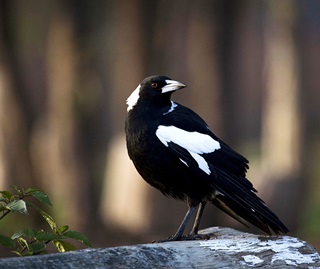 Many people encounter wildlife in their daily lives. Most of these interactions are positive, encourage appreciation of our natural environment and are consistent with people and wildlife coexisting together. However, animals may display defensive behaviours in response to perceived or actual threats of harm or other interactions with people or other animals. These defensive behaviours may be seen as aggressive to people encountering them and can pose a threat of serious injury or disease, damage to property or cause economic hardship.
Many people encounter wildlife in their daily lives. Most of these interactions are positive, encourage appreciation of our natural environment and are consistent with people and wildlife coexisting together. However, animals may display defensive behaviours in response to perceived or actual threats of harm or other interactions with people or other animals. These defensive behaviours may be seen as aggressive to people encountering them and can pose a threat of serious injury or disease, damage to property or cause economic hardship.
The management of interactions between people and wildlife seeks to prioritise the safety of people and minimise risks of harm or damage while considering the protection status and biological needs of animals to achieve positive and lasting outcomes.
All native birds, reptiles, amphibians and mammals (except the dingo) are protected in New South Wales by the Biodiversity Conservation Act 2016 (BC Act). The National Parks and Wildlife Service (NPWS) has specific responsibilities for conserving wildlife within and outside national parks and reserves.
This policy provides the framework to support National Parks and Wildlife Service (NPWS)'s role in managing interactions between people and wildlife in New South Wales. It covers species that are protected under the BC Act. It also covers native species protected on NPWS-managed lands under the National Parks and Wildlife Act 1974 (NPW Act). It considers the offences of harming (section 2.1 BC Act) and liberating (section 2.6 BC Act) animals under the BC Act, along with related offences for the protection of animals under the National Parks and Wildlife Regulation 2019 (NPW Reg).
Implementation of this policy will be supported by procedures that provide guidance on how to record and respond to specific wildlife interaction issues. Given the need to balance animal welfare and public safety, this policy will remain under review and updated as needed.
Exclusions
This policy does not address:
- dingoes – which are managed under the Wild Dog Policy
- non-native pest species – which are covered by the Biosecurity Act 2015 and managed off-park by Local Land Services and the Department of Primary Industries (DPI), and on park by NPWS
- to avoid doubt, this policy does not apply to wild horse management activities in accordance with approved management plans
- native animals kept in captivity – which may occur for a range of purposes
- NPWS manages native animals kept as pets, or temporarily housed for rehabilitation or research
- native animals kept for display are managed by Department of Primary Industries
- commercial kangaroo management – which occurs via the Kangaroo Management Program
- flying-fox camp management – which is undertaken in accordance with the Flying-fox Camp Management Code of Practice
- marine wildlife – which is protected under the BC Act
- the NPWS response to marine wildlife incidents is guided by the Marine Wildlife Management Manual
- translocation of species to establish, reintroduce or supplement populations for conservation purposes – which are addressed under the Translocation Operational Policy
- wildlife rehabilitation – which is managed under the Rehabilitation of Protected Animals Policy
Principles
- We share our cities, towns, suburbs, properties and spaces with wildlife. NPWS encourages a positive and understanding approach to living with wildlife, but recognises that sometimes conflict between people and wildlife can occur.
- Landholders have a shared responsibility to manage their properties and businesses to minimise the potential for conflict with wildlife.
- NPWS seeks to minimise risks of harm to people and damage to property, while ensuring the health, welfare and sustainability of wildlife populations.
- NPWS takes a balanced, risk-based approach to managing wildlife incidents, applying scientific principles based on best available evidence, the precautionary principle and prioritising animal welfare.
- Animal welfare is a key consideration in managing wildlife issues. Non-lethal methods to manage wildlife will be used where possible and where this supports optimal animal welfare or conservation outcomes.
- NPWS recognises that relocation of animals may be an option in some circumstances, but that it may not always achieve the desired outcome and can result in moving the problem or only providing short-term relief until another animal replaces the relocated animal. It may also cause stress and suffering of the animal during capture and transport, and injury or death upon release.
- relocation is therefore likely to be supported only in limited situations where there is evidence that moving an animal will successfully mitigate the landholder's problem and that any welfare impacts on the relocated animal will be minor and short-term.
- NPWS recognises that wildlife species are spiritually significant to Aboriginal people and are an important part of their culture and identity.

